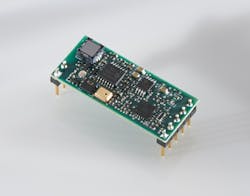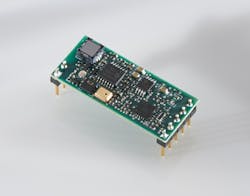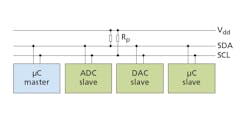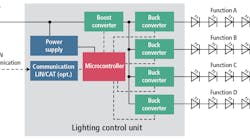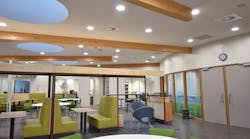LED-based lighting will represent 65% of the total indoor luminaire market worldwide in 2022 — less than four years from now — according to a Strategies Unlimited presentation made at the Strategies in Light conference earlier this year. This critical mass point opens up a realm of possibilities and opportunities for solid-state lighting (SSL) luminaire developers and engineers. Luminaires can now integrate a great deal more intelligence via sensors to collect data, and monitor not only the integral luminaire system and operation but also a vast range of conditions exterior to the luminaire in the spaces that the fixtures light. Furthermore, luminaires can integrate radios adjacent to these sensor modules to feed all the data gathered to asset and facility managers, both algorithmic and human, and bring the Internet of Things (IoT) concept to SSL. Let’s examine a potential development approach.
Opening lighting to smarts
The changeover to mainly LED sources in lighting fixtures is giving luminaire development teams new leeway to easily add intelligence. With SSL, developers start from the conceptual phase knowing they can count on little additional heat from the light source’s operation. Temperature and humidity sensing, once only possible in separate thermostats relatively far from lighting fixtures, and passive infrared (PIR) occupancy sensors, once the domain of separate security system nodes, can easily be integrated into luminaires. Light sensors for capturing light data and for, say, signaling the fixture to come on at sunset don’t need to be in a separate wall- or ceiling-mounted switch plate that’s built with a wired or wireless connection to the fixture if the fixture itself can house this capability. PIR sensors so commonly seen in wall switch plates and ceiling-mounted modules can instead be housed in the luminaire.
FIG. 1. The AmbiMate multisensor module integrates occupancy, humidity, temperature, and air quality sensing capabilities and transmits all the data over a single interface.
Integration of such sensing in luminaires promises significant cost savings in terms of building infrastructure installation and maintenance that can be eliminated. Imagine an office building wiring installation that allows for integration of all needed sensors, including for temperature and humidity, into the luminaire. This removes the need for a separate HVAC (heating, ventilation, and air conditioning) infrastructure. Master electrician man-hours are reduced, as are building electrical design and engineering hours, and fees are cut. In the top US metropolitan markets, electricians for installation are commonly billed out at rates in the range of $140 per hour. Electrical engineering for new commercial fit-outs are billed to clients at rates over $200 per hour.
Suppliers to the luminaire industry have developed modules that combine these four sensors, with the capability to add other sensors including VOC (volatile organic compound) sensors for air quality, CO2 (carbon dioxide) detectors, and even a microphone to monitor sound levels. Luminaire engineers are showing a preference for these multisensor modules, because when they are engineered in a single integral module, the module can be easily linked with a single, bidirectional intra-luminaire interface. Fig. 1 depicts the TE Connectivity AmbiMate module that can easily be integrated into luminaires, enabling the sensing functionality.
FIG. 2. The I2C digital interface is used in electronic systems to wirelessly connect multiple ICs — chips including microcontrollers, communication modules, and more.
There are a number of options for connecting sensor modules with other luminaire subsystems. An I2C (inter-integrated circuit — pronounced I squared C) interface is one good choice. As the name implies, the interface is regularly used to connect multiple ICs or chips including microcontrollers, data converters, communication peripherals, and more in a wide variety of electronic systems (Fig. 2). A single I2C output from an integrated sensor module collectively combines all the sensors’ data. The communications integration task is simpler and easier than having four to six analog I/O connections from different sensors to integrate. The interface can also link directly to a wireless module for transmission of sensor data to a central management system and control commands back to the luminaire (Fig. 3).
The CO2 challenge
Now let’s discuss why such sensing is important. With the right sensor module integration, LED lighting can take the promise of human-centric lighting even further. Prompted by intense interest in making buildings healthy and optimally hospitable to humans, the global WELL Building initiative has realized standards and certification for architects and building engineers. (See the Industry Insights article from this issue for more information on WELL.) One key focus, often the first focus, is air quality, albeit more so for Europeans because in North America one finds that safety and security take precedence.
A first principal of air quality universally is levels of CO2. Fresh outside air has CO2 levels measured at around 400 ppm (parts per million). At levels greater than 1000 ppm, humans become drowsy and uncomfortable. The 5000-ppm level is generally considered a maximum threshold. This is vital information for workplace productivity and for optimal learning in work and educational settings. The European Commission is expected to mandate every classroom have a CO2 detector going forward.
But since CO2 is an inert gas, it is difficult to measure. Conventional sensors are expensive and large. A non-dispersive infrared CO2 sensor system commercially available today retails for around US $1200 and is the size of a tissue box. This level of cost and complexity is not in line with ubiquitous deployment.
FIG. 3. A module such as AmbiMate can use I2C to link with communication modules and networks such as Bluetooth Mesh for connection with a central management system.
Sensor module makers in tune with SSL volume production needs and bill of materials demands offer a different route. A sensor that detects VOCs and applies intelligence to that number via the module controller can yield an equivalent CO2 (eCO2) reading accurately and inexpensively. The global lighting manufacturers already offer control system software that will use this data to pass off to the building HVAC and/or signal occupants to take a break or increase airflow.
Smart lighting getting a lot smarter
Smart SSL systems will further enable new applications based on the sensing capability. Spend even an hour at an industry event such as LightFair International, and one quickly sees that global lighting system leaders see their products merging with the building automation and building controls space. You can see that trend in the LEDs Magazine coverage of LightFair that took place this past May.
By gathering more, better, and a broader range of data from the spaces being lit, the LED lighting can be put to its best use and deliver maximum efficiency. The trend benefits the system owner in utility costs, lighting lifetime, and the reduction of necessary building infrastructure to install and maintain. Still, the bigger picture for LED luminaire engineers is the plans that their system software counterparts are devising.
The lighting system architecture and the software built for it can gather intelligence from the sensors throughout, and build intelligence over time by learning from how the lighting was used over the myriad temperature, occupancy, and atmospheric states observed. These new classes of lighting and building control systems will be constantly measuring and assessing the spaces illuminated and gathering a great deal of data on what is happening there. Then that data can be further analyzed to yield new insights on lighting preferences and optimal lighting conditions. It seems imperative that luminaire engineers bring as much sensing capability as possible into their designs. Applications can ultimately include optimization of office space utilization.
Sensor module and luminaire connectivity
Of course, developers face multiple challenges in getting data and control information to and from many luminaires, perhaps additional sensors, and a management system. As mentioned earlier, the integral sensor module can use the ubiquitous I2C protocol. But such modules must link to the management system and the LED driver.
One of the benefits of I2C is the ease of connection to a radio module, especially Bluetooth 5.0 in conjunction with the relatively new Bluetooth Mesh technology. With the now-ratified Bluetooth Mesh standard, a signal is flooded to all network nodes rather than directed down a particular path. Lighting IoT experts see this step forward as massively reducing the challenge of designing wireless systems in buildings with metal infrastructure that interferes with the wireless data signals.
Moreover, the lighting engineering-focused Zhaga Consortium is also working on standards for outputting sensor data to common industry interfaces, and for the electrical and mechanical connections from sensor modules to light fixtures. Groups, consortia, and the traditional standards-making bodies, of course, are in a phase of tremendous activity as LED lighting design “goes native,” as it were.
Zhaga came to this issue early with a host of solutions for simplifying luminaire design with standard fit systems. This helps the industry eliminate wires and components and integrate smart features. These system-level refinements make room for adding the sensor modules and communication components that make luminaires smarter and better connected to one another and to cloud-based control and analytics software. Modules can be attached to the luminaire PCB (printed-circuit board) via very straightforward castellation, or header and plated through-hole techniques the module supplier has decades of experience engineering.
There are also many options in a connection between a sensor module or dedicated controller and an LED driver. In a win for global luminaire manufacturers, the digitally-addressable lighting interface (DALI) and especially DALI-2 have been developed concomitantly with IEC 62386 so the industry may be able to avoid too much variance for different regions and geographies. Multisensor module makers are doing the work for lighting system customers of ensuring compliance to these standards, e.g., DALI-2 section 304 for light sensors. And a DALI-2 interface is a good option for driver control.
With standardized power supplies and control units for LED drivers, arriving at a luminaire board layout that will accommodate a defined sensor module that can be utilized across a whole product platform becomes possible. Because many sensors yield analog output, combining them in one module that converts all the analog outputs to a single digital output is ideal. The fewer interfaces for the system engineer, the better. Ideally, the luminaire engineering team could gain access to the module’s microcontroller and be working with just five active signals on the module PCB, perhaps two more if a sound sensor were desired.
With the increase in luminaire electronic content that comes with sensor integration, a combined temperature and humidity sensor will be valuable not just for human-centric lighting but also for keeping tabs on the health of the lighting system itself.
JONATHAN CATCHPOLE is system architect in the Swindon, UK technology center for TE Connectivity’s Industrial business. A Six Sigma Black Belt, Catchpole’s career has spanned roles in mechanical and electrical engineering and engineering management. His educational background includes a 2:1 BEng Hons, Mechanical and Manufacturing Engineering. He can be reached at [email protected].
